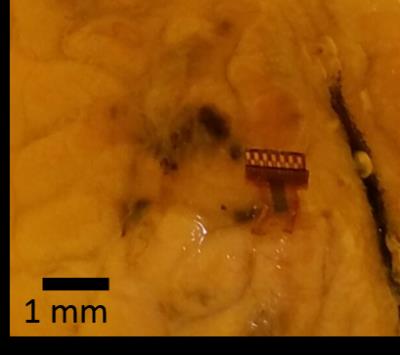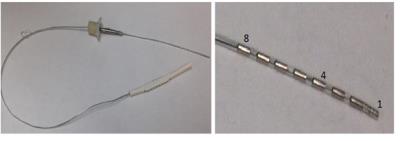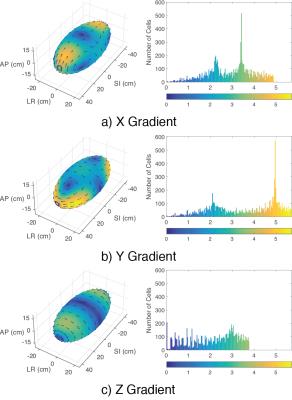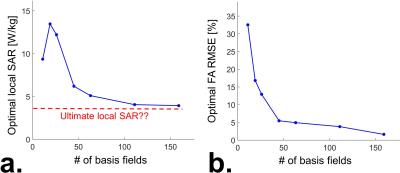MR Contrast & EM Safety
Electronic Poster
MRI Safety
Thursday, 27 April 2017
| Exhibition Hall |
14:00 - 15:00 |
| |
|
Computer # |
 |
5561.
 |
97 |
Contrast Deposition Within the Dentate Nucleus After Repetitive Administration: Comparison of Linear versus Macrocyclic Gadolinium Contrast Agents 
Eugene Huo, Bing Tian, David Saloner, Michael Hope, Christopher Hess, William Dillon, Thomas Hope
Although gadolinium deposition in nephrogenic systemic fibrosis is limited to patients with abnormal renal function, more recent rat and human studies have demonstrated gadolinium deposition in specific brain structures in subjects without renal failure. We report here one of the largest studies evaluating gadolinium deposition in terms of both number of patients and number of doses, verifying the impact of the structural differences between the two most commonly used classes of agents (linear vs macrocyclic) and demonstrating a previously undescribed plateau in signal intensity ratio increase in patients who have received more than 25 administrations of gadolinium.
|
|
5562.
 |
98 |
Gadolinium Containing Metabolites in Brain Tissue. A Study in Rats - permission withheld
Thomas Frenzel, Gregor Jost, Chirag Apte, Hubertus Pietsch
After the repeated dosing of linear or macrocyclic GBCAs in rats, the brain was fractionated 3 and 24d p.i. Cerebrum, cerebellum and pons were separated, homogenized and divided into an insoluble and soluble fraction, which was separated into low and high molecular weight molecules. The gadolinium concentration in the brain was very low. A large portion of the Gd in the linear GBCA groups was found in the insoluble fraction and a smaller portion in large macromolecules. The Gd in the macrocyclic GBCA groups was only found in the soluble fraction and in small molecules. Gd excretion was still ongoing.
|
|
5563.
 |
99 |
In vivo measurements of gadolinium accumulation in bone of healthy individuals following administration of gadolinium-based contrast agents: a pilot study 
Michelle Lord, Fiona McNeill, James Gräfe, Michael Noseworthy, David Chettle
The use of gadolinium (Gd) based contrast agents is being questioned due to its recently discovered retention in healthy individuals following administration. Our newest generation x-ray fluorescence system has been used in a small pilot study for in vivo Gd measurements in bones of healthy individuals, who have previously received these contrast agents. Preliminary results show a significant difference between the Gd-exposed and control groups, suggesting Gd accumulation in healthy individuals. Our system has performed the first human in vivo measurement of Gd in bone and has the potential to be used in further studies of accumulation in the body.
|
 |
5564.
 |
100 |
Characterization of Gadolinium Deposition in the Brain Manifest as T2-hypointensity and T1-hyperintensity Associated with Repeat Monthly Triple-Dose Gadopentetate Dimeglumine Administration for 2 years in the BECOME Trial 
Paul DiCamillo, Michael Shvarts, Ravi Patel, Jhimli Mitra, Pallavi Tiwari, Stuart Cook, Diego Cadavid, Robert Naismith, Samantha Lancia, Leo Wolansky
We characterize the brain parenchymal deposition of Gadolinium (Gd) in the dentate nucleus (DN) and globus pallidus (GP) in a cohort of 16 subjects with multiple sclerosis (MS), each of whom had systematically received one year of serial monthly triple dose Gd (3-dose Gd) and optional additional monthly exposure for a second year. Progressive increase in T1 signal and decrease in T2 signal is found in both the dentate nucleus and globus pallidus.
|
|
5565.
 |
101 |
SKIN ENHANCEMENT WITH GADOLINIUM BASED CONTRAST AGENTS 
Akira YAMAMOTO, Tsutomu OKADA, Yasutaka FUSHIMI, Tomohisa OKADA, Kaori TOGASHI
Skin tissue showed enhancement after GBCA administration. This phenomenon was confirmed by profile curve analysis. Subtraction image between pre-post contrast was calculated after image registration. This subtraction image showed distinct contrast effect of the skin tissue and may be helpful for the clinical diagnosis.
|
|
5566.
 |
102 |
Comparison of Gd-DTPA-BMA versus Gd-DOTA of Gadolinium retention in human bone tissue with renal function 
Takaki Maeda, Hitomi Hara, Toshihiro Akisue, Yuki Iwama, Ryosuke Kuroda, Masahiko Fujii, Kazuro Sugimura
The purpose of this study was to determine the gadolinium (Gd) retention in human bone tissue after administration of Gd contrast agent such as macrocyclic (Gd-DOTA) or linear (Gd-DTPA-BMA) chelate at a standard single clinical dose and to evaluate its correlation with renal function.
|
|
5567.
 |
103 |
Gadolinium presence in the brain: Detection and quantification of gadolinium based contrast agents in the cerebrospinal fluid in rats - permission withheld
Gregor Jost, Thomas Frenzel, Jessica Lohrke, Diana Lenhard, Shinji Naganawa, Hubertus Pietsch
The infiltration of six marketed and one experimental gadolinium based contrast agents (GBCA) from blood into the cerebrospinal fluid (CSF) was evaluated in rats by repeated fluid attenuated (FLAIR) MRI up to 4h. Quantitative gadolinium measurements in CSF samples (4.5 and 24h) were performed by ICP-MS. No differences in penetration and distribution into the CSF were observed for the marketed GBCAs. FLAIR imaging demonstrates a kinetic from the inner CSF cavities to the subarachnoid space, suggesting an infiltration via the choroid plexus and a passive distribution with CSF flow. After 24h an almost complete GBCA clearance from CSF was observed.
|
|
5568.
 |
104 |
A Manganese-Based Alternative to Gadolinium: Contrast Enhanced MR Angiography at 3T and In Vivo Stability 
Eric Gale, Hsiao-Ying Wey, Ian Ramsay, David Sosnovik, Peter Caravan
We evaluated the efficacy of a new manganese-based contrast agent, Mn-PyC3A, in contrast-enhanced MR angiography by comparison to Gd-DTPA in a baboon model at 3T. Mn-PyC3A clearance was assessed by dynamically scanning the excretory organs and performing serial blood draws out to 60 min. Mn-PyC3A plasma clearance and metabolism were quantified from the drawn blood. Mn-PyC3A generates equivalent vessel-to-muscle contrast-to-noise ratios as Gd-DTPA at 3T, clears via a mixed renal and hepatobiliary pathway, and is excreted unchanged. Mn-PyC3A is a functionally equivalent gadolinium-free alternative for contrast-enhanced MRI angiography.
|
|
5569.
|
105 |
Ferumoxytol as an Alternative to Gadolinium-based MRI Applications in Patients With and Without Renal Impairment: Acute and Short-term Safety Experience 
Kim-Lien Nguyen, Takegawa Yoshida, Isidro Salusky, Peng Hu, J. Paul Finn
Recent concerns about gadolinium deposition in biologic tissues and discontinuation of gadofosveset trisodium have created increased interest in the off-label use of ferumoxytol as an MRI contrast agent. Limited safety data relating to the diagnostic use of ferumoxytol are available. We summarize our safety experience with ferumoxytol as an alternative MRI contrast agent in 285 unique patients (314 injections) with all levels of renal function.
|
|
5570.
 |
106 |
Immediate Reactions to Gadolinium Based Contrast Agents: a Meta-Analysis 
Ashkan Heshmatzadeh Behzadi, Yize Zhao, Zerwa Farooq, Martin Prince
Recently there has been increased attention focused on GBCA safety and data on the numbers of reactions have begun to be reported in large Studies. Here we combine data from multiple papers in a meta-analysis to determine if certain GBCA or classes of GBCA may have different immediate reaction profiles.
|
|
5571.
 |
107 |
Impact of renal impairment on T1-weighted signal increase and gadolinium presence in the rat brain after multiple administrations of gadolinium based contrast agents - permission withheld
Hubertus Pietsch, Thomas Frenzel, Jessica Lohrke, Gregor Jost
The impact of renal insufficiency on the T1-weighted signal intensity (SI) increase in the cerebellar nuclei (CN) and on the brain gadolinium concentration was evaluated by comparing 5/6-nephrectomized to healthy control rats. Eight weeks after repeated high-dose GBCA administrations a significantly higher CN/pons SI ratio compared to a saline control group was found for linear GBCAs. This was independent of the renal status. No altered SI ratios compared to the saline group were observed after administration of macrocyclic GBCAs. Inductive coupled plasma mass spectrometry revealed higher gadolinium concentrations for all GBCAs in the cerebellum of renally impaired rats.
|
|
5572.
|
108 |
T1-signal increases as a marker of Gd-deposition in pediatric brain: findings after multiple exposures to gadobenate dimeglumine 
Guenther Schneider, Paul Raczeck, Arno Buecker, Jonas Stroeder
The possibility of Gd deposition in the pediatric brain following exposure to GBCAs is a potentially serious issue. Our study of 34 pediatric patients that received between 5 and 15 administrations of low dose (0.05 mmol/kg bodyweight) gadobenate dimeglumine (MultiHance; Bracco) revealed no differences in T1-signal in the DN, GP, pons and thalamus relative to measurements made in 24 age- and weight-matched control subjects that had never been exposed to any GBCA. Likewise no meaningful differences were seen in DN–pons and GP–thalamus SI ratios. We consider low dose gadobenate to be safe and effective for diagnosis and routine follow-up of pediatric oncologic patients.
|
|
5573.
 |
109 |
Strong enhancement of relaxivity of gadolinium contrast agent in solution with intracellular viscosity: Quantitative estimation of the deposited contrast agent in the brain 
Ken Masuyama, Masayuki Taguchi, Toru Yamamoto
High T1-weighted signal appears in brain of patients who have experienced MRI examinations using gadolinium contrast agent several times. The relaxation effect of gadolinium contrast agent strongly depends on the viscosity of the solution, and the average viscosity in the cell is higher than that of the free water. However, the relaxation effect of the gadolinium contrast agent in the cell has been unknown. In this study, we investigated the longitudinal relaxivity of it – concentration dependence of longitudinal relaxation rate in solution with intracellular viscosity. The intracellular viscosity strongly enhances the longitudinal relaxivity of the gadolinium contrast agent.
|
|
5574.
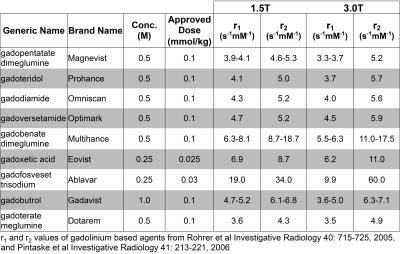 |
110 |
Gadolinium Calculator for Safe Dosing of Gadolinium Based Contrast Agents 
Scott Reeder, Elizabeth Simcock, Bryan Ramirez, Joseph Rowley, Howard Rowley
In this work, we describe the design, implementation, and utilization of an online and smartphone gadolinium calculator used to calculate gadolinium-based contrast agent (GBCA) dose. By providing a readily available, reliable, and rapid means of calculating the volume of a GBCA, we aim to ensure accurate dosing so as to avoid accidental over- or under-dosing. Utilization tracking demonstrated progressively increasing use of the online gadolinium calculator with a total of 22,074 page visits from 68 countries, logged during a 9-month tracking period.
|
|
5575.
 |
111 |
Impact of Abdominal Magnetic Resonance Imaging on DNA Double Strand-Breaks in Human Blood Lymphocytes - video not available
Saravanabavaan Suntharalingam, Emil Mladenov, Georg Iliakis, Michael Forsting, Oliver Kraff, Harald Quick, Kai Nassenstein
Magnetic resonance imaging is considered to be a safe alternative to other imaging techniques that use ionizing radiation, such as computed tomography. Initially driven by X-ray and CT imaging studies, within the recent years different in vitro and in vivo studies analyzed the impact of MR imaging on DNA integrity in human lymphocytes but reported contradictory results. In this study on patients referred to clinical abdominal MRI, γ-H2AX immunofluorescence microscopy was used to determine DNA integrity. No evidence of DNA damage induced by abdominal MRI in a clinical setting was found.
|
|
5576.
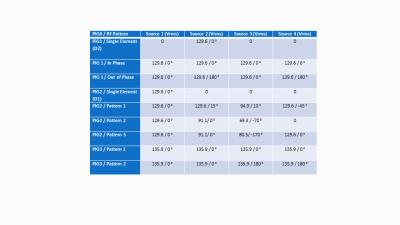 |
112 |
RF Heating Studies on Anesthetized Swine Using Fractionated Dipole Antennas at 10.5 T 
Yigitcan Eryaman, Russell Lagore, Arcan Erturk, Lynn Utecht, Patrick Zhang, Angel Torrado-Carvajal, Esra Abaci Turk, Lance DelaBarre, Gregory Metzger, Gregor Adriany, Kamil Ugurbil, J. Thomas Vaughan
We measured temperature increase (ΔT) in anesthetized swine using fluoroscopic probes and compared our results to the simulated solutions obtained from digital models of the same swine. For our studies, we used a 4 channel fractionated dipole array that is placed on the neck/upper back region. Electromagnetic and thermal simulations were performed along with in vivo experiments with different RF excitation patterns at 10.5 T.
|
|
5577.
 |
113 |
RF safety assessment of a 32-channel integrated body coil for 7 Tesla: Thermal dose evaluation at high SAR level - permission withheld
Thomas Fiedler, Stephan Orzada, Martina Flöser, Harald Quick, Mark Ladd, Andreas Bitz
RF safety assessment for a 32-ch body coil for 7T was performed based on SAR, tissue temperature, and a thermal dose model (CEM43°C). Temperature simulations considered a temperature-dependent thermoregulation. The tissue temperature limit is exceeded when SAR limits are adhered to. However, based on the thermal dose limit, the maximum input power determined from SAR limits can be exceeded by up to a factor of 5 without noticeable limitations in permissible exposure time in MR examinations. This increased input power allows for improved B1+homogeneity with 50% reduced flip angle error compared to the input power determined from SAR limits.
|
|
5578.
 |
114 |
The effect of variable amniotic fluid conductivity and fetal tissues properties on B1+ and local SAR for fetal imaging at 3T 
Shaihan Malik, Jeffrey Hand, Joseph Hajnal
Effects on B1+ and local specific absorption rate of varying the conductivity of fetal tissues and amniotic fluid ($$$\sigma_{AF}$$$) in a model of a 7 month pregnant woman within a 3T birdcage coil are investigated numerically. Results indicate that a realistic value of $$$\sigma_{AF}$$$ is required to estimate power to produce a chosen B1+ in the fetus and fetal SAR10g. Fetal properties adjusted for gestational age impact on B1+ and result in increased fetal SAR10g compared to adult value based simulations. Smaller changes in SAR10g are predicted between detailed fetal models and homogeneous ones with volume weighted average dielectric properties.
|
|
5579.
 |
115 |
Assessment of specific absorption rate and energy deposition in over 14,000 clinical MRI examination at 1.5 and 3 Tesla scanners 
Amir Ali Rahsepar, Laleh Golestanirad, Hassan Haji-Valizadeh, Haris Saybasili , Julie Blaisdell , Michael Markl, John Kirsch, James Carr, Jeremy Collins
Although SAR value is an important factor in device heating, but this study also provides information about the other factors like the total amount of delivered RF energy, time period of RF delivery and most importantly the pause between pulse sequences should be considered
|
|
5580.
 |
116 |
Optimization of the order and spacing of the sequences to reduce the maximum SAR-induced temperature reached during an MRI examination 
Giuseppe Carluccio, Christopher Collins
We demonstrate that the maximum SAR-induced temperature in an examination can be lowered with strategic ordering of the sequences in the exam. Using numerical simulations, here we optimize the order of and time between sequences in a spine exam to minimize the maximum temperature reached in a human body model without increasing the duration of the exam. The optimized sequence has a maximum temperature 0.63 C lower than the original.
|
|
5581.
 |
117 |
Peripheral Nerve Stimulation in MRI: Insights from a three level analysis and coupled EM-electrophysiological simulations in neuro-functionalized human models 
Antonino Cassara', Esra Neufeld, Gisela Hagberg, Manuel Guidon, Klaus Scheffler, Niels Kuster
The mechanisms of peripheral nerve stimulation (PNS) induced by the fast switching of MRI gradient coils are only partially understood, stimulation sites and E-field (or dB/dt) thresholds show large inter-subject variability and neurostimulation models based on the amphibian SENN axon model are not ideal. We propose a 3 level computational investigation that combines analysis of E-field exposure, of activation functions, and of multi-parametric EM-electrophysiological simulations in neuro-functionalized human models for different axon models and gradient waveforms. Results concerning E-field/dB/dt thresholds values and sites of neurostimulation are compared with published experimental data. A functional uncertainty analysis is also provided.
|
|
5582.
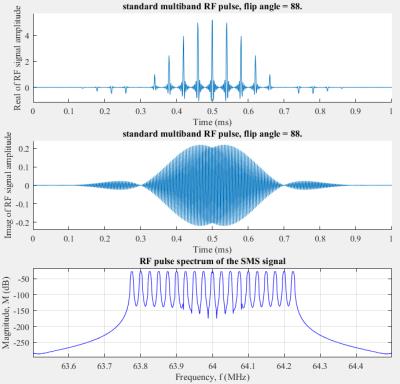 |
118 |
Evaluation of SMS sequence on the AIMD MRI model validation 
Yuliang Du, Xi Lin Chen, Will Lui, Shi Feng, Shiloh Sison
Impacts of SMS imaging technique on the AIMD design, transfer function measurement, model calculation and system validation were thoroughly analyzed. The RF frequency broadening from the SMS imaging sequence has minimal impacts to the existing device design and test methodology.
|
|
5583.
 |
119 |
Graphene for MRI Applications at 7T: Opportunities for SAR reduction 
Gianluigi Tiberi, Guo Liu, Raj Mittra, Michela Tosetti
SAR management is critical at ultra-high field (UHF) strength where RF field energy deposition in the subject increases and its distribution becomes very inhomogeneous. Here we illustrate simulation results for a test example in order to show how a graphene sheet can be used to obtain a SAR reduction without sacrificing the coil efficiency significantly. Specifically, the presence of the graphene sheet leads a maximum local SAR reduction up to 47%. Thus, from the simulation here shown, it follows that graphene sheets can be successfully used in MRI applications at 7T for enhancing the safety with respect to SAR issue
|
|
5584.
 |
120 |
Safety and Function of Programmable Ventriculo-Peritoneal Shunt Valves: An in vitro 7 Tesla Magnetic Resonance Imaging Study 
Karsten Wrede, Bixia Chen, Ulrich Sure, Harald Quick, Oliver Kraff
This in vitro study tests function, safety and image artifacts of the two worldwide most frequently implanted programmable VP-shunt valves in a 7 Tesla whole body MRI system. Both tested programmable VP-shunt valves lost their ability to be reprogramed after exposure to the static magnetic field and are therefore unsafe for use in 7 Tesla whole body scanners in their current design. Magnetic coercivity of the permanent magnets in the programming mechanisms was insufficient. Image artifacts adjacent to the valves, however, were tolerable.
|
|



